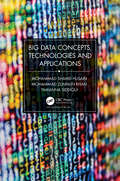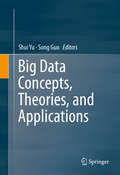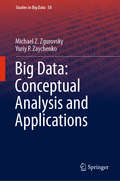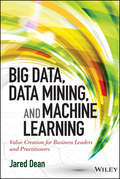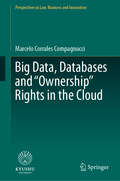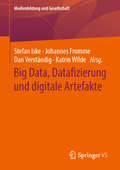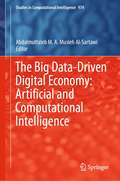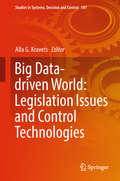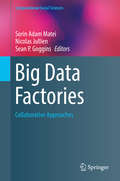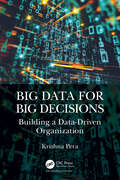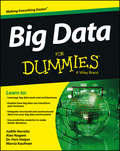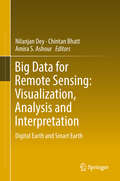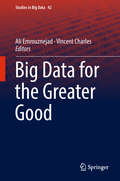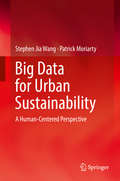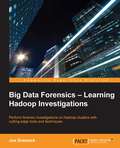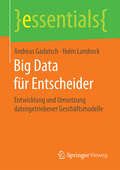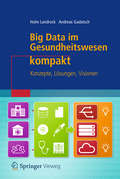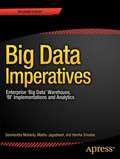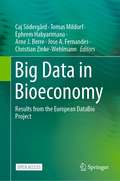- Table View
- List View
Big Data Computing and Communications: Second International Conference, BigCom 2016, Shenyang, China, July 29-31, 2016. Proceedings (Lecture Notes in Computer Science #9784)
by Yu Wang Ge Yu Yanyong Zhang Zhu Han Guoren WangThis book constitutes the proceedings of the Second International Conference on Big Data Computing and Communications, BigCom 2016, held in Shenyang, China, in July 2016. The 39 papers presented in this volume were carefully reviewed and selected from 90 submissions. BigCom is an international symposium dedicated to addressing the challenges emerging from big data related computing and networking. The conference is targeted to attract researchers and practitioners who are interested in Big Data analytics, management, security and privacy, communication and high performance computing in its broadest sense.
Big Data Concepts, Technologies, and Applications
by Mohammad Shahid Husain Mohammad Zunnun Khan Tamanna SiddiquiWith the advent of such advanced technologies as cloud computing, the Internet of Things, the Medical Internet of Things, the Industry Internet of Things and sensor networks as well as the exponential growth in the usage of Internet-based and social media platforms, there are enormous oceans of data. These huge volumes of data can be used for effective decision making and improved performance if analyzed properly. Due to its inherent characteristics, big data is very complex and cannot be handled and processed by traditional database management approaches. There is a need for sophisticated approaches, tools and technologies that can be used to store, manage and analyze these enormous amounts of data to make the best use of them. Big Data Concepts, Technologies, and Applications covers the concepts, technologies, and applications of big data analytics. Presenting the state-of-the-art technologies in use for big data analytics. it provides an in-depth discussion about the important sectors where big data analytics has proven to be very effective in improving performance and helping industries to remain competitive. This book provides insight into the novel areas of big data analytics and the research directions for the scholars working in the domain. Highlights include: The advantages, disadvantages and challenges of big data analytics State-of-the-art technologies for big data analytics such as Hadoop, NoSQL databases, data lakes, deep learning and blockchain The application of big data analytic in healthcare, business, social media analytics, fraud detection and prevention and governance Exploring the concepts and technologies behind big data analytics, the book is an ideal resource for researchers, students, data scientists, data analysts and business analysts who need insight into big data analytics
Big Data Concepts, Technologies, and Applications
by Mohammad Shahid Husain Mohammad Zunnun Khan Tamanna SiddiquiWith the advent of such advanced technologies as cloud computing, the Internet of Things, the Medical Internet of Things, the Industry Internet of Things and sensor networks as well as the exponential growth in the usage of Internet-based and social media platforms, there are enormous oceans of data. These huge volumes of data can be used for effective decision making and improved performance if analyzed properly. Due to its inherent characteristics, big data is very complex and cannot be handled and processed by traditional database management approaches. There is a need for sophisticated approaches, tools and technologies that can be used to store, manage and analyze these enormous amounts of data to make the best use of them. Big Data Concepts, Technologies, and Applications covers the concepts, technologies, and applications of big data analytics. Presenting the state-of-the-art technologies in use for big data analytics. it provides an in-depth discussion about the important sectors where big data analytics has proven to be very effective in improving performance and helping industries to remain competitive. This book provides insight into the novel areas of big data analytics and the research directions for the scholars working in the domain. Highlights include: The advantages, disadvantages and challenges of big data analytics State-of-the-art technologies for big data analytics such as Hadoop, NoSQL databases, data lakes, deep learning and blockchain The application of big data analytic in healthcare, business, social media analytics, fraud detection and prevention and governance Exploring the concepts and technologies behind big data analytics, the book is an ideal resource for researchers, students, data scientists, data analysts and business analysts who need insight into big data analytics
Big Data Concepts, Theories, and Applications
by Shui Yu Song GuoThis book covers three major parts of Big Data: concepts, theories and applications. Written by world-renowned leaders in Big Data, this book explores the problems, possible solutions and directions for Big Data in research and practice. It also focuses on high level concepts such as definitions of Big Data from different angles; surveys in research and applications; and existing tools, mechanisms, and systems in practice. Each chapter is independent from the other chapters, allowing users to read any chapter directly. After examining the practical side of Big Data, this book presents theoretical perspectives. The theoretical research ranges from Big Data representation, modeling and topology to distribution and dimension reducing. Chapters also investigate the many disciplines that involve Big Data, such as statistics, data mining, machine learning, networking, algorithms, security and differential geometry. The last section of this book introduces Big Data applications from different communities, such as business, engineering and science. Big Data Concepts, Theories and Applications is designed as a reference for researchers and advanced level students in computer science, electrical engineering and mathematics. Practitioners who focus on information systems, big data, data mining, business analysis and other related fields will also find this material valuable.
Big Data: Conceptual Analysis and Applications (Studies in Big Data #58)
by Michael Z. Zgurovsky Yuriy P. ZaychenkoThe book is devoted to the analysis of big data in order to extract from these data hidden patterns necessary for making decisions about the rational behavior of complex systems with the different nature that generate this data. To solve these problems, a group of new methods and tools is used, based on the self-organization of computational processes, the use of crisp and fuzzy cluster analysis methods, hybrid neural-fuzzy networks, and others. The book solves various practical problems. In particular, for the tasks of 3D image recognition and automatic speech recognition large-scale neural networks with applications for Deep Learning systems were used. Application of hybrid neuro-fuzzy networks for analyzing stock markets was presented. The analysis of big historical, economic and physical data revealed the hidden Fibonacci pattern about the course of systemic world conflicts and their connection with the Kondratieff big economic cycles and the Schwabe–Wolf solar activity cycles. The book is useful for system analysts and practitioners working with complex systems in various spheres of human activity.
Big Data, Data Mining, and Machine Learning: Value Creation for Business Leaders and Practitioners (Wiley and SAS Business Series)
by Jared DeanWith big data analytics comes big insights into profitability Big data is big business. But having the data and the computational power to process it isn't nearly enough to produce meaningful results. Big Data, Data Mining, and Machine Learning: Value Creation for Business Leaders and Practitioners is a complete resource for technology and marketing executives looking to cut through the hype and produce real results that hit the bottom line. Providing an engaging, thorough overview of the current state of big data analytics and the growing trend toward high performance computing architectures, the book is a detail-driven look into how big data analytics can be leveraged to foster positive change and drive efficiency. With continued exponential growth in data and ever more competitive markets, businesses must adapt quickly to gain every competitive advantage available. Big data analytics can serve as the linchpin for initiatives that drive business, but only if the underlying technology and analysis is fully understood and appreciated by engaged stakeholders. This book provides a view into the topic that executives, managers, and practitioners require, and includes: A complete overview of big data and its notable characteristics Details on high performance computing architectures for analytics, massively parallel processing (MPP), and in-memory databases Comprehensive coverage of data mining, text analytics, and machine learning algorithms A discussion of explanatory and predictive modeling, and how they can be applied to decision-making processes Big Data, Data Mining, and Machine Learning provides technology and marketing executives with the complete resource that has been notably absent from the veritable libraries of published books on the topic. Take control of your organization's big data analytics to produce real results with a resource that is comprehensive in scope and light on hyperbole.
Big Data, Data Mining, and Machine Learning: Value Creation for Business Leaders and Practitioners (Wiley and SAS Business Series)
by Jared DeanWith big data analytics comes big insights into profitability Big data is big business. But having the data and the computational power to process it isn't nearly enough to produce meaningful results. Big Data, Data Mining, and Machine Learning: Value Creation for Business Leaders and Practitioners is a complete resource for technology and marketing executives looking to cut through the hype and produce real results that hit the bottom line. Providing an engaging, thorough overview of the current state of big data analytics and the growing trend toward high performance computing architectures, the book is a detail-driven look into how big data analytics can be leveraged to foster positive change and drive efficiency. With continued exponential growth in data and ever more competitive markets, businesses must adapt quickly to gain every competitive advantage available. Big data analytics can serve as the linchpin for initiatives that drive business, but only if the underlying technology and analysis is fully understood and appreciated by engaged stakeholders. This book provides a view into the topic that executives, managers, and practitioners require, and includes: A complete overview of big data and its notable characteristics Details on high performance computing architectures for analytics, massively parallel processing (MPP), and in-memory databases Comprehensive coverage of data mining, text analytics, and machine learning algorithms A discussion of explanatory and predictive modeling, and how they can be applied to decision-making processes Big Data, Data Mining, and Machine Learning provides technology and marketing executives with the complete resource that has been notably absent from the veritable libraries of published books on the topic. Take control of your organization's big data analytics to produce real results with a resource that is comprehensive in scope and light on hyperbole.
Big Data, Databases and "Ownership" Rights in the Cloud (Perspectives in Law, Business and Innovation)
by Marcelo Corrales CompagnucciTwo of the most important developments of this new century are the emergence of cloud computing and big data. However, the uncertainties surrounding the failure of cloud service providers to clearly assert ownership rights over data and databases during cloud computing transactions and big data services have been perceived as imposing legal risks and transaction costs. This lack of clear ownership rights is also seen as slowing down the capacity of the Internet market to thrive. Click-through agreements drafted on a take-it-or-leave-it basis govern the current state of the art, and they do not allow much room for negotiation. The novel contribution of this book proffers a new contractual model advocating the extension of the negotiation capabilities of cloud customers, thus enabling an automated and machine-readable framework, orchestrated by a cloud broker.Cloud computing and big data are constantly evolving and transforming into new paradigms where cloud brokers are predicted to play a vital role as innovation intermediaries adding extra value to the entire life cycle. This evolution will alleviate the legal uncertainties in society by means of embedding legal requirements in the user interface and related computer systems or its code. This book situates the theories of law and economics and behavioral law and economics in the context of cloud computing and takes database rights and ownership rights of data as prime examples to represent the problem of collecting, outsourcing, and sharing data and databases on a global scale. It does this by highlighting the legal constraints concerning ownership rights of data and databases and proposes finding a solution outside the boundaries and limitations of the law. By allowing cloud brokers to establish themselves in the market as entities coordinating and actively engaging in the negotiation of service-level agreements (SLAs), individual customers as well as small and medium-sized enterprises could efficiently and effortlessly choose a cloud provider that best suits their needs. This approach, which the author calls “plan-like architectures,” endeavors to create a more trustworthy cloud computing environment and to yield radical new results for the development of the cloud computing and big data markets.
Big Data, Datafizierung und digitale Artefakte (Medienbildung und Gesellschaft #42)
by Johannes Fromme Dan Verständig Stefan Iske Katrin WildeDer Band fokussiert Entwicklungen und Problemstellungen rund um das Verhältnis des Menschen zu Daten und Zahlen sowie die daran geknüpften Implikationen für Medien, Bildung und Gesellschaft. Ausgangspunkte bilden hierbei auf der einen Seite Big Data und Tendenzen der Datafizierung sozialer Prozesse, auf der anderen Seite Transformationen des Ästhetischen im Hinblick auf kreativ-ästhetische Praktiken. Der Band versammelt dabei unterschiedliche theoretische Positionen, die sich gemeinsam an zentralen Fragen der Medienbildung und kulturellen Bildung im digitalen Zeitalter orientieren.
The Big Data-Driven Digital Economy: Artificial and Computational Intelligence (Studies in Computational Intelligence #974)
by Abdalmuttaleb M. A. Musleh Al-SartawiThis book shows digital economy has become one of the most sought out solutions to sustainable development and economic growth of nations. This book discusses the implications of both artificial intelligence and computational intelligence in the digital economy providing a holistic view on AI education, economics, finance, sustainability, ethics, governance, cybersecurity, blockchain, and knowledge management. Unlike other books, this book brings together two important areas, intelligence systems and big data in the digital economy, with special attention given to the opportunities, challenges, for education, business growth, and economic progression of nations. The chapters hereby focus on how societies can take advantage and manage data, as well as the limitations they face due to the complexity of resources in the form of digital data and the intelligence which will support economists, financial managers, engineers, ICT specialists, digital managers, data managers, policymakers, regulators, researchers, academics, students, economic development strategies, and the efforts made by the UN towards achieving their sustainability goals.
Big Data-driven World: Legislation Issues and Control Technologies (Studies in Systems, Decision and Control #181)
by Alla G. KravetsThis book examines the methodological foundations of the Big Data-driven world, formulates its concept within the frameworks of modern control methods and theories, and approaches the peculiarities of Control Technologies as a specific sphere of the Big Data-driven world, distinguished in the modern Digital Economy. The book studies the genesis of mathematical and information methods’ transition from data analysis & processing to knowledge discovery and predictive analytics in the 21st century. In addition, it analyzes the conditions of development and implementation of Big Data analysis approaches in investigative activities and determines the role and meaning of global networks as platforms for the establishment of legislation and regulations in the Big Data-driven world.The book examines that world through the prism of Legislation Issues, substantiate the scientific and methodological approaches to studying modern mechanisms of terrorism and extremism counteraction in the conditions of new challenges of dissemination and accessibility of socially dangerous information. Systematization of successful experience of the Big Data solutions implementation in the different countries and analyze causal connections of the Digital Economy formation from the positions of new technological challenges is performed.The book’s target audience includes scientists, students, PhD and Master students who conduct scientific research on the topic of Big Data not only in the field of IT& data science, but also in connection with legislative regulation aspects of the modern information society. It also includes practitioners and experts, as well as state authorities and representatives of international organizations interested in creating mechanisms for implementing Digital Economy projects in the Big Data-driven world.
Big Data Factories: Collaborative Approaches (Computational Social Sciences)
by Sorin Adam Matei Nicolas Jullien Sean P. GogginsThe book proposes a systematic approach to big data collection, documentation and development of analytic procedures that foster collaboration on a large scale. This approach, designated as “data factoring” emphasizes the need to think of each individual dataset developed by an individual project as part of a broader data ecosystem, easily accessible and exploitable by parties not directly involved with data collection and documentation. Furthermore, data factoring uses and encourages pre-analytic operations that add value to big data sets, especially recombining and repurposing.The book proposes a research-development agenda that can undergird an ideal data factory approach. Several programmatic chapters discuss specialized issues involved in data factoring (documentation, meta-data specification, building flexible, yet comprehensive data ontologies, usability issues involved in collaborative tools, etc.). The book also presents case studies for data factoring and processing that can lead to building better scientific collaboration and data sharing strategies and tools.Finally, the book presents the teaching utility of data factoring and the ethical and privacy concerns related to it.Chapter 9 of this book is available open access under a CC BY 4.0 license at link.springer.com
Big Data Finance in China (Contributions to Finance and Accounting)
by Mengyao Lin Wei Chen Wenting ZhangThis book starts by introducing the background of the era of data elements, clarifies the theoretical basis and technical methods related to big data, and analyzes the specific application of big data technology in China’s banking industry, the insurance industry, securities investment industry, third-party payment, risk supervision, and other fields. application, and thereby finally summarize useful experiences for big data development as well as effective regulation and supervision. We hope that this book can help with subsequent research and application of big data technology in the financial field. This book has a broad audience, especially scholars and practitioners. It is a valuable reference for researchers in related fields, and it can also provide some insights into financial regulators’ awareness of big data finance. Furthermore, it aids in formulating and improving consumption policies, adjusting economic structures, and preventing risks under financial innovation. This research provides valuable guidance for improving financial innovation as well as the effective regulation thereon by financial regulators.
Big Data for Big Decisions: Building a Data-Driven Organization
by Krishna PeraBuilding a data-driven organization (DDO) is an enterprise-wide initiative that may consume and lock up resources for the long term. Understandably, any organization considering such an initiative would insist on a roadmap and business case to be prepared and evaluated prior to approval. This book presents a step-by-step methodology in order to create a roadmap and business case, and provides a narration of the constraints and experiences of managers who have attempted the setting up of DDOs. The emphasis is on the big decisions – the key decisions that influence 90% of business outcomes – starting from decision first and reengineering the data to the decisions process-chain and data governance, so as to ensure the right data are available at the right time, every time. Investing in artificial intelligence and data-driven decision making are now being considered a survival necessity for organizations to stay competitive. While every enterprise aspires to become 100% data-driven and every Chief Information Officer (CIO) has a budget, Gartner estimates over 80% of all analytics projects fail to deliver intended value. Most CIOs think a data-driven organization is a distant dream, especially while they are still struggling to explain the value from analytics. They know a few isolated successes, or a one-time leveraging of big data for decision making does not make an organization data-driven. As of now, there is no precise definition for data-driven organization or what qualifies an organization to call itself data-driven. Given the hype in the market for big data, analytics and AI, every CIO has a budget for analytics, but very little clarity on where to begin or how to choose and prioritize the analytics projects. Most end up investing in a visualization platform like Tableau or QlikView, which in essence is an improved version of their BI dashboard that the organization had invested into not too long ago. The most important stakeholders, the decision-makers, are rarely kept in the loop while choosing analytics projects. This book provides a fail-safe methodology for assured success in deriving intended value from investments into analytics. It is a practitioners’ handbook for creating a step-by-step transformational roadmap prioritizing the big data for the big decisions, the 10% of decisions that influence 90% of business outcomes, and delivering material improvements in the quality of decisions, as well as measurable value from analytics investments. The acid test for a data-driven organization is when all the big decisions, especially top-level strategic decisions, are taken based on data and not on the collective gut feeling of the decision makers in the organization.
Big Data for Big Decisions: Building a Data-Driven Organization
by Krishna PeraBuilding a data-driven organization (DDO) is an enterprise-wide initiative that may consume and lock up resources for the long term. Understandably, any organization considering such an initiative would insist on a roadmap and business case to be prepared and evaluated prior to approval. This book presents a step-by-step methodology in order to create a roadmap and business case, and provides a narration of the constraints and experiences of managers who have attempted the setting up of DDOs. The emphasis is on the big decisions – the key decisions that influence 90% of business outcomes – starting from decision first and reengineering the data to the decisions process-chain and data governance, so as to ensure the right data are available at the right time, every time. Investing in artificial intelligence and data-driven decision making are now being considered a survival necessity for organizations to stay competitive. While every enterprise aspires to become 100% data-driven and every Chief Information Officer (CIO) has a budget, Gartner estimates over 80% of all analytics projects fail to deliver intended value. Most CIOs think a data-driven organization is a distant dream, especially while they are still struggling to explain the value from analytics. They know a few isolated successes, or a one-time leveraging of big data for decision making does not make an organization data-driven. As of now, there is no precise definition for data-driven organization or what qualifies an organization to call itself data-driven. Given the hype in the market for big data, analytics and AI, every CIO has a budget for analytics, but very little clarity on where to begin or how to choose and prioritize the analytics projects. Most end up investing in a visualization platform like Tableau or QlikView, which in essence is an improved version of their BI dashboard that the organization had invested into not too long ago. The most important stakeholders, the decision-makers, are rarely kept in the loop while choosing analytics projects. This book provides a fail-safe methodology for assured success in deriving intended value from investments into analytics. It is a practitioners’ handbook for creating a step-by-step transformational roadmap prioritizing the big data for the big decisions, the 10% of decisions that influence 90% of business outcomes, and delivering material improvements in the quality of decisions, as well as measurable value from analytics investments. The acid test for a data-driven organization is when all the big decisions, especially top-level strategic decisions, are taken based on data and not on the collective gut feeling of the decision makers in the organization.
Big Data For Dummies
by Judith S. Hurwitz Alan Nugent Fern Halper Marcia KaufmanFind the right big data solution for your business or organization Big data management is one of the major challenges facing business, industry, and not-for-profit organizations. Data sets such as customer transactions for a mega-retailer, weather patterns monitored by meteorologists, or social network activity can quickly outpace the capacity of traditional data management tools. If you need to develop or manage big data solutions, you'll appreciate how these four experts define, explain, and guide you through this new and often confusing concept. You'll learn what it is, why it matters, and how to choose and implement solutions that work. Effectively managing big data is an issue of growing importance to businesses, not-for-profit organizations, government, and IT professionals Authors are experts in information management, big data, and a variety of solutions Explains big data in detail and discusses how to select and implement a solution, security concerns to consider, data storage and presentation issues, analytics, and much more Provides essential information in a no-nonsense, easy-to-understand style that is empowering Big Data For Dummies cuts through the confusion and helps you take charge of big data solutions for your organization.
Big Data For Dummies
by Judith S. Hurwitz Alan Nugent Fern Halper Marcia KaufmanFind the right big data solution for your business or organization Big data management is one of the major challenges facing business, industry, and not-for-profit organizations. Data sets such as customer transactions for a mega-retailer, weather patterns monitored by meteorologists, or social network activity can quickly outpace the capacity of traditional data management tools. If you need to develop or manage big data solutions, you'll appreciate how these four experts define, explain, and guide you through this new and often confusing concept. You'll learn what it is, why it matters, and how to choose and implement solutions that work. Effectively managing big data is an issue of growing importance to businesses, not-for-profit organizations, government, and IT professionals Authors are experts in information management, big data, and a variety of solutions Explains big data in detail and discusses how to select and implement a solution, security concerns to consider, data storage and presentation issues, analytics, and much more Provides essential information in a no-nonsense, easy-to-understand style that is empowering Big Data For Dummies cuts through the confusion and helps you take charge of big data solutions for your organization.
Big Data for Remote Sensing: Digital Earth and Smart Earth
by Nilanjan Dey Chintan Bhatt Amira S. AshourThis book thoroughly covers the remote sensing visualization and analysis techniques based on computational imaging and vision in Earth science. Remote sensing is considered a significant information source for monitoring and mapping natural and man-made land through the development of sensor resolutions that committed different Earth observation platforms. The book includes related topics for the different systems, models, and approaches used in the visualization of remote sensing images. It offers flexible and sophisticated solutions for removing uncertainty from the satellite data. It introduces real time big data analytics to derive intelligence systems in enterprise earth science applications. Furthermore, the book integrates statistical concepts with computer-based geographic information systems (GIS). It focuses on image processing techniques for observing data together with uncertainty information raised by spectral, spatial, and positional accuracy of GPS data. The book addresses several advanced improvement models to guide the engineers in developing different remote sensing visualization and analysis schemes. Highlights on the advanced improvement models of the supervised/unsupervised classification algorithms, support vector machines, artificial neural networks, fuzzy logic, decision-making algorithms, and Time Series Model and Forecasting are addressed. This book guides engineers, designers, and researchers to exploit the intrinsic design remote sensing systems. The book gathers remarkable material from an international experts' panel to guide the readers during the development of earth big data analytics and their challenges.
Big Data for the Greater Good (Studies in Big Data #42)
by Ali Emrouznejad Vincent CharlesThis book highlights some of the most fascinating current uses, thought-provoking changes, and biggest challenges that Big Data means for our society. The explosive growth of data and advances in Big Data analytics have created a new frontier for innovation, competition, productivity, and well-being in almost every sector of our society, as well as a source of immense economic and societal value. From the derivation of customer feedback-based insights to fraud detection and preserving privacy; better medical treatments; agriculture and food management; and establishing low-voltage networks – many innovations for the greater good can stem from Big Data. Given the insights it provides, this book will be of interest to both researchers in the field of Big Data, and practitioners from various fields who intend to apply Big Data technologies to improve their strategic and operational decision-making processes.
Big Data for Urban Sustainability: A Human-Centered Perspective
by Stephen Jia Wang Patrick MoriartyThis book presents a practical framework for the application of big data, cloud, and pervasive and complex systems to sustainable solutions for urban environmental challenges. It covers the technologies, potential, and possible and impact of big data on energy efficiency and the urban environment.The book first introduces key aspects of big data, cloud services, pervasive computing, and mobile technologies from a pragmatic design perspective, including sample open source firmware. Cloud services, mobile and embedded platforms, interfaces, operating system design methods, networking, and middleware are all considered. The authors then explore in detail the framework, design principles, architecture and key components of developing energy systems to support sustainable urban environments. The included case study provides a pathway to improve the eco-efficiency of urban transport, demonstrating how to design an energy efficient next generation urban navigation system by leveraging vast cloud data sets on user-behavior. Ultimately, this resource maps big data’s pivotal intersection with rapid global urbanization along the path to a sustainable future.
Big Data Forensics – Learning Hadoop Investigations
by Joe SremackPerform forensic investigations on Hadoop clusters with cutting-edge tools and techniques About This Book • Identify, collect, and analyze Hadoop evidence forensically • Learn about Hadoop's internals and Big Data file storage concepts • A step-by-step guide to help you perform forensic analysis using freely available tools Who This Book Is For This book is meant for statisticians and forensic analysts with basic knowledge of digital forensics. They do not need to know Big Data Forensics. If you are an IT professional, law enforcement professional, legal professional, or a student interested in Big Data and forensics, this book is the perfect hands-on guide for learning how to conduct Hadoop forensic investigations. Each topic and step in the forensic process is described in accessible language. What You Will Learn • Understand Hadoop internals and file storage • Collect and analyze Hadoop forensic evidence • Perform complex forensic analysis for fraud and other investigations • Use state-of-the-art forensic tools • Conduct interviews to identify Hadoop evidence • Create compelling presentations of your forensic findings • Understand how Big Data clusters operate • Apply advanced forensic techniques in an investigation, including file carving, statistical analysis, and more In Detail Big Data forensics is an important type of digital investigation that involves the identification, collection, and analysis of large-scale Big Data systems. Hadoop is one of the most popular Big Data solutions, and forensically investigating a Hadoop cluster requires specialized tools and techniques. With the explosion of Big Data, forensic investigators need to be prepared to analyze the petabytes of data stored in Hadoop clusters. Understanding Hadoop's operational structure and performing forensic analysis with court-accepted tools and best practices will help you conduct a successful investigation. Discover how to perform a complete forensic investigation of large-scale Hadoop clusters using the same tools and techniques employed by forensic experts. This book begins by taking you through the process of forensic investigation and the pitfalls to avoid. It will walk you through Hadoop's internals and architecture, and you will discover what types of information Hadoop stores and how to access that data. You will learn to identify Big Data evidence using techniques to survey a live system and interview witnesses. After setting up your own Hadoop system, you will collect evidence using techniques such as forensic imaging and application-based extractions. You will analyze Hadoop evidence using advanced tools and techniques to uncover events and statistical information. Finally, data visualization and evidence presentation techniques are covered to help you properly communicate your findings to any audience. Style and approach This book is a complete guide that follows every step of the forensic analysis process in detail. You will be guided through each key topic and step necessary to perform an investigation. Hands-on exercises are presented throughout the book, and technical reference guides and sample documents are included for real-world use.
Big Data für Entscheider: Entwicklung und Umsetzung datengetriebener Geschäftsmodelle (essentials)
by Andreas Gadatsch Holm LandrockAndreas Gadatsch und Holm Landrock zeigen an typischen Beispielen aus der Praxis, wie datengetriebene Geschäftsmodelle entstehen. Sie erläutern, wie sich Big-Data-Projekte rechnen und wie man am einfachsten an die Analyse großer Datenmengen herangeht. Eine Bewertung der zentralen Aspekte von Projekten und der dort eingesetzten Technologien erleichtert den Lesern die tägliche Praxis im IT-Management. Die Autoren stellen Hadoop als eine der wichtigen Big-Data-Technologien vor.
Big Data im Gesundheitswesen kompakt: Konzepte, Lösungen, Visionen (IT kompakt)
by Holm Landrock Andreas GadatschDas kompakte Fachbuch gibt einen Überblick über die Möglichkeiten von „Big Data“ im Gesundheitswesen und beschreibt anhand von ausgewählten Szenarien mögliche Einsatzgebiete.Die Autoren erläutern zentrale Systemkomponenten und IT-Standards und thematisieren anhand wichtiger Daten des Gesundheitswesens die Notwendigkeit der Strukturierung und Modellierung von Daten. Das Buch gibt Hinweise wie Geschäftsprozesse im Gesundheitswesen dokumentiert, analysiert und verbessert werden können. Anwendungsszenarien, wie die Datenanalysen für Krankenhäuser, Labore, Versicherungen und die Pharmaindustrie, zeigen die praktische Relevanz des Themas. Aber auch rechtliche und ethische Aspekte werden inhaltlich angeschnitten.Ein Buch für Entscheider in der medizinischen Leitung und Verwaltung von Krankenhäusern, Fachleute sowie niedergelassene Ärzte und Apotheker, aber auch Personen in Ausbildung und Studium im Gesundheitswesen.
Big Data Imperatives: Enterprise Big Data Warehouse, BI Implementations and Analytics
by Soumendra Mohanty Madhu Jagadeesh Harsha SrivatsaBig Data Imperatives, focuses on resolving the key questions on everyone’s mind: Which data matters? Do you have enough data volume to justify the usage? How you want to process this amount of data? How long do you really need to keep it active for your analysis, marketing, and BI applications?Big data is emerging from the realm of one-off projects to mainstream business adoption; however, the real value of big data is not in the overwhelming size of it, but more in its effective use.This book addresses the following big data characteristics: Very large, distributed aggregations of loosely structured data – often incomplete and inaccessible Petabytes/Exabytes of data Millions/billions of people providing/contributing to the context behind the data Flat schema's with few complex interrelationships Involves time-stamped events Made up of incomplete data Includes connections between data elements that must be probabilistically inferred Big Data Imperatives explains 'what big data can do'. It can batch process millions and billions of records both unstructured and structured much faster and cheaper. Big data analytics provide a platform to merge all analysis which enables data analysis to be more accurate, well-rounded, reliable and focused on a specific business capability.Big Data Imperatives describes the complementary nature of traditional data warehouses and big-data analytics platforms and how they feed each other. This book aims to bring the big data and analytics realms together with a greater focus on architectures that leverage the scale and power of big data and the ability to integrate and apply analytics principles to data which earlier was not accessible. This book can also be used as a handbook for practitioners; helping them on methodology,technical architecture, analytics techniques and best practices. At the same time, this book intends to hold the interest of those new to big data and analytics by giving them a deep insight into the realm of big data.
Big Data in Bioeconomy: Results from the European DataBio Project
by Christian Zinke-Wehlmann Caj Södergård Tomas Mildorf Ephrem Habyarimana Arne J. Berre Jose A. FernandesThis edited open access book presents the comprehensive outcome of The European DataBio Project, which examined new data-driven methods to shape a bioeconomy. These methods are used to develop new and sustainable ways to use forest, farm and fishery resources. As a European initiative, the goal is to use these new findings to support decision-makers and producers – meaning farmers, land and forest owners and fishermen.With their 27 pilot projects from 17 countries, the authors examine important sectors and highlight examples where modern data-driven methods were used to increase sustainability. How can farmers, foresters or fishermen use these insights in their daily lives? The authors answer this and other questions for our readers. The first four parts of this book give an overview of the big data technologies relevant for optimal raw material gathering. The next three parts put these technologies into perspective, by showing useable applications from farming, forestry and fishery. The final part of this book gives a summary and a view on the future.With its broad outlook and variety of topics, this book is an enrichment for students and scientists in bioeconomy, biodiversity and renewable resources.

